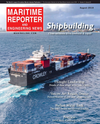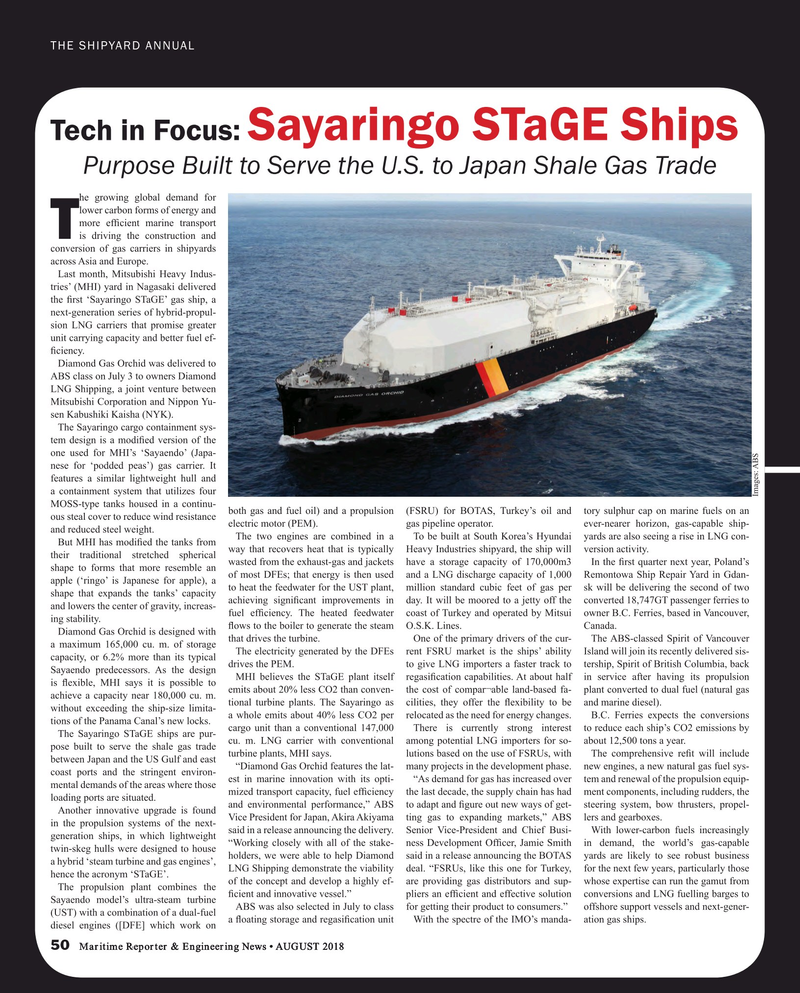
Page 50: of Maritime Reporter Magazine (August 2018)
The Shipyard Edition
Read this page in Pdf, Flash or Html5 edition of August 2018 Maritime Reporter Magazine
THE SHIPYARD ANNUAL
Tech in Focus: Sayaringo STaGE Ships
Purpose Built to Serve the U.S. to Japan Shale Gas Trade he growing global demand for lower carbon forms of energy and more ef? cient marine transport
Tis driving the construction and conversion of gas carriers in shipyards across Asia and Europe.
Last month, Mitsubishi Heavy Indus- tries’ (MHI) yard in Nagasaki delivered the ? rst ‘Sayaringo STaGE’ gas ship, a next-generation series of hybrid-propul- sion LNG carriers that promise greater unit carrying capacity and better fuel ef- ? ciency.
Diamond Gas Orchid was delivered to
ABS class on July 3 to owners Diamond
LNG Shipping, a joint venture between
Mitsubishi Corporation and Nippon Yu- sen Kabushiki Kaisha (NYK).
The Sayaringo cargo containment sys- tem design is a modi? ed version of the one used for MHI’s ‘Sayaendo’ (Japa- nese for ‘podded peas’) gas carrier. It features a similar lightweight hull and a containment system that utilizes four
Images: ABS
MOSS-type tanks housed in a continu- both gas and fuel oil) and a propulsion (FSRU) for BOTAS, Turkey’s oil and tory sulphur cap on marine fuels on an ous steal cover to reduce wind resistance electric motor (PEM). gas pipeline operator. ever-nearer horizon, gas-capable ship- and reduced steel weight.
The two engines are combined in a To be built at South Korea’s Hyundai yards are also seeing a rise in LNG con-
But MHI has modi? ed the tanks from their traditional stretched spherical way that recovers heat that is typically Heavy Industries shipyard, the ship will version activity.
shape to forms that more resemble an wasted from the exhaust-gas and jackets have a storage capacity of 170,000m3 In the ? rst quarter next year, Poland’s apple (‘ringo’ is Japanese for apple), a of most DFEs; that energy is then used and a LNG discharge capacity of 1,000 Remontowa Ship Repair Yard in Gdan- shape that expands the tanks’ capacity to heat the feedwater for the UST plant, million standard cubic feet of gas per sk will be delivering the second of two achieving signi? cant improvements in day. It will be moored to a jetty off the converted 18,747GT passenger ferries to and lowers the center of gravity, increas- fuel ef? ciency. The heated feedwater coast of Turkey and operated by Mitsui owner B.C. Ferries, based in Vancouver, ing stability.
? ows to the boiler to generate the steam O.S.K. Lines. Canada.
Diamond Gas Orchid is designed with a maximum 165,000 cu. m. of storage that drives the turbine. One of the primary drivers of the cur- The ABS-classed Spirit of Vancouver
The electricity generated by the DFEs rent FSRU market is the ships’ ability Island will join its recently delivered sis- capacity, or 6.2% more than its typical
Sayaendo predecessors. As the design drives the PEM. to give LNG importers a faster track to tership, Spirit of British Columbia, back
MHI believes the STaGE plant itself regasi? cation capabilities. At about half in service after having its propulsion is ? exible, MHI says it is possible to emits about 20% less CO2 than conven- the cost of compar¬able land-based fa- plant converted to dual fuel (natural gas achieve a capacity near 180,000 cu. m. tional turbine plants. The Sayaringo as cilities, they offer the ? exibility to be and marine diesel).
without exceeding the ship-size limita- a whole emits about 40% less CO2 per relocated as the need for energy changes. B.C. Ferries expects the conversions tions of the Panama Canal’s new locks.
cargo unit than a conventional 147,000 There is currently strong interest to reduce each ship’s CO2 emissions by
The Sayaringo STaGE ships are pur- pose built to serve the shale gas trade cu. m. LNG carrier with conventional among potential LNG importers for so- about 12,500 tons a year.
turbine plants, MHI says. lutions based on the use of FSRUs, with The comprehensive re? t will include between Japan and the US Gulf and east “Diamond Gas Orchid features the lat- many projects in the development phase. new engines, a new natural gas fuel sys- coast ports and the stringent environ- est in marine innovation with its opti- “As demand for gas has increased over tem and renewal of the propulsion equip- mental demands of the areas where those mized transport capacity, fuel ef? ciency the last decade, the supply chain has had ment components, including rudders, the loading ports are situated.
Another innovative upgrade is found and environmental performance,” ABS to adapt and ? gure out new ways of get- steering system, bow thrusters, propel-
Vice President for Japan, Akira Akiyama ting gas to expanding markets,” ABS lers and gearboxes.
in the propulsion systems of the next- generation ships, in which lightweight said in a release announcing the delivery. Senior Vice-President and Chief Busi- With lower-carbon fuels increasingly “Working closely with all of the stake- ness Development Of? cer, Jamie Smith in demand, the world’s gas-capable twin-skeg hulls were designed to house holders, we were able to help Diamond said in a release announcing the BOTAS yards are likely to see robust business a hybrid ‘steam turbine and gas engines’,
LNG Shipping demonstrate the viability deal. “FSRUs, like this one for Turkey, for the next few years, particularly those hence the acronym ‘STaGE’.
The propulsion plant combines the of the concept and develop a highly ef- are providing gas distributors and sup- whose expertise can run the gamut from
Sayaendo model’s ultra-steam turbine ? cient and innovative vessel.” pliers an ef? cient and effective solution conversions and LNG fuelling barges to
ABS was also selected in July to class for getting their product to consumers.” offshore support vessels and next-gener- (UST) with a combination of a dual-fuel diesel engines ([DFE] which work on a ? oating storage and regasi? cation unit With the spectre of the IMO’s manda- ation gas ships. 50 Maritime Reporter & Engineering News • AUGUST 2018
MR #8 (50-57).indd 50 MR #8 (50-57).indd 50 8/6/2018 11:09:46 AM8/6/2018 11:09:46 AM

 49
49

 51
51
